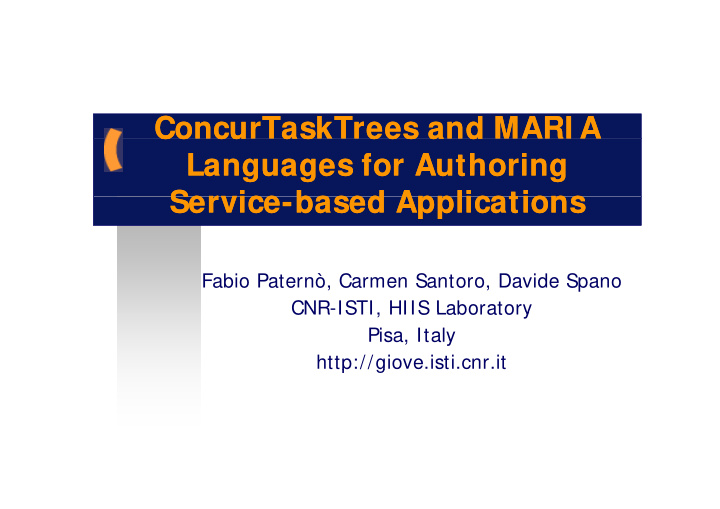



ConcurTaskTrees Co cu Co cu ConcurTaskTrees and MARI A as as ees ees a d and MARI A a d Languages for Authoring Languages for Authoring Service Service-based Service based Service based Applications based Applications Applications Applications Fabio Paternò, Carmen Santoro, Davide Spano CNR-ISTI, HIIS Laboratory CNR ISTI, HIIS Laboratory Pisa, Italy http://giove.isti.cnr.it p //g
Mark Mark- -up up Languages Languages for for Model M d l M d l b Model-based b based Approaches d d A Approaches A h h UIML, XForms, TERESA, UsiXML ACM TOCHI Special Issue, NESSI Roadmap ACM TOCHI Special Issue NESSI Roadmap Need for novel solutions able to: support access to a number of pre-existing Web services that can be distributed everywhere se ces t at ca be d st buted e e y e e support access to various interaction modalities (multi-touch gestures voice (multi touch gestures, voice, …) ) support ability to change the content of user interfaces dynamically interfaces dynamically
MARI A XML MARI A XML Features Features Support for Data Model Useful for specifying the format of input values, association of U f l f if i th f t f i t l i ti f various data objects to the various interactors, .. Events at abstract/concrete levels / Property change events / Activation events (e.g. access to a web service or a database) Extended Dialogue Model Extended Dialogue Model Conditions and CTT operators for event handlers, including support for parallel input Able to support user interfaces including complex and Ajax scripts Continuously updating of fields without explicit user request Continuously updating of fields without explicit user request Dynamic set of user interface elements Conditional connections between presentations p Possibility to change only a part of a UI
MetaModel The AUI MetaModel The AUI
Support Service Support Service- -Oriented Oriented Applications Applications Applications Applications Web services are increasingly used to support b l d remote access to application functionalities Services are defined previous to the interactive Services are defined previous to the interactive applications Applications are built through composing such Applications are built through composing such services Service composition Se ce co pos t o at the Service level, at the Application level, at the Application level, at the User Interface level 5
UI Annotations for Web services UI Annotations for Web services (EU ServFace Project) (EU ServFace Project) Th The hints do not have the aim of defining the whole hi d h h i f d fi i h h l interface They can address various aspects (presentation, content, dynamic behaviour) They should be independent of the UI implementation language p g g They can have various granularities They can abstract from the platform (if necessary) They can abstract from the platform (if necessary) Examples: Labels, icons, validation data rules, optional/mandatory fields, … ti l/ d t fi ld
Support Support for for Applications Applications based based on on Web Services Web Services Web Services Web Services
The Proposed The Proposed Design p Design Approach g Approach pp pp First a bottom-up step in order to analyse the Web services providing functionalities useful for the new application to develop. Analysis of the operations and the data types associated with input and output parameters is carried out in order to associate them with suitable abstract interaction d d h h bl b objects Task model expressed in ConcurTaskTrees (CTT) for describing the interactive application and how it assumes that tasks are performed. pp p Design based on user requirements Indicate how to compose functionalities implemented in different Web services, which are associated with system tasks. Level of granularity to reach in the task decomposition Level of granularity to reach in the task decomposition. Associating the system basic tasks to the web services Associate each system basic task with the operations of the web services. Thus, if a Web Service supports three operations, then there would be three basic system tasks tasks. Transformation of Task Models into MARIA Descriptions Temporal operators indicate requirements for UI dialogue model Task hierarchy provides information regarding grouping of UI elements Task hierarchy provides information regarding grouping of UI elements Type of task indicates type of interactor Use information from tasks/operation bindings Inclusion of annotations in resulting Abstract/Concrete Specification Editing Abstract/Concrete Specification User Interface Generation
Service, Tasks Service, Tasks and and Annotations Annotations Service and Tasks/Operations annotations Task Model binding
Editing Editing Environment Environment Interactive Tree Elements and Visual View attributes Specification
Current Current Current State Current State State State Concrete Languages (desktop smartphones Concrete Languages (desktop, smartphones with gestures, mobile, vocal, multimodal combination of graphical and vocal) bi ti f hi l d l) Implementation languages (XHTML, SMIL, p a o a guag s ( , S , VoiceXML, X+ V, planned HTML 5 and JSP for Web service access) for Web service access) Next week remote test with people working in software companies, any volunteer?
Recommend
More recommend